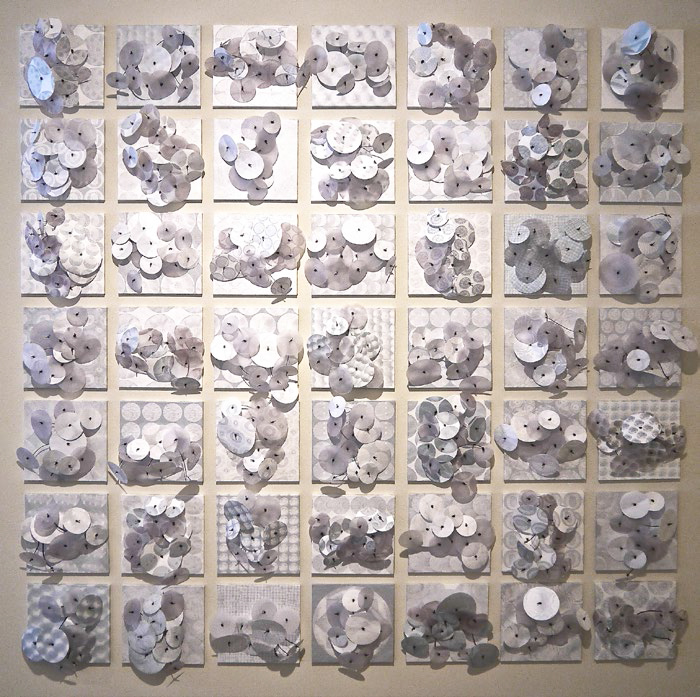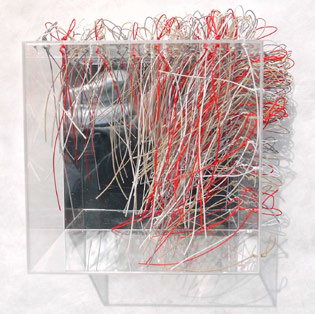Architecture in Fabric - Page 3
 |
|
|
 |
|
|
 |
|
|
 |
|
|
"It also takes a person with a lot of discipline to do that. You are committed to it, and you are going to do it. And when it is done, it is very beautiful. When you look at Ealish's work, you don't see an image, you don't see a beautiful landscape. But it still provokes you. 'Who could do that sort of thing?' I could not do it. "
Ealish has done even larger installations in the past, in her pre-smocking days. She did two of these with Leona Collins—one in Scotland and the other on the Isle of Man, where Ealish is from. She remains a proud Manx woman, as people on the island are called.
One immense work was a series of fabric sails that hung above a restaurant in Edinburgh's Ocean Terminal shopping center, "with the purpose of hiding all the ducts, conduits etc., while also providing acoustic dampening and an aesthetic appearance," Collins writes.
Another, which remains one of Ealish's favorite works and illustrates her love for places, was created in 2003 for a hospital on the Isle of Man, 'Manx Day Out.'
"The final piece was inspired by photographs Ealish took of various architecture and scenes around the island," Collins writes. "It was the first time we explored digital sublimation printing on a large scale. The final piece was a printed, stitched, and pleated sailcloth hanging that hung the length of the building's four-story open stairway. The actual length of cloth used was three times the overall hanging length, due to the amount of pleating that was done—by hand!"
Ealish says, "I love that all these years later it really gives people solace. I'm really proud to have created that piece and people love to look at it. People will know where the places are on the island."
It was on the Isle of Man that Ealish attended a high school that was "very arts-centric," with an art room that was open all day. She returned to the island at age ten, after living in Germany, where her dad served in the forces.
In later years, she also lived with her family in Dubai and Oman, soaking up the tradition of colored textiles in those lands, and also landing a royal commission—a piece for the dining room of Sheikh Mohammed bin Rashid Al Maktoum, Dubai's leader. She never met him nor visited the palace.
But it was Japan more than the Gulf that made Ealish the artist she is today. "Japan completely changed my art—and my life, actually, I have to say—in the way I appreciate life," she says.
By the time Ealish went to Japan, in 2003, she was already an accomplished artist. She had studied with Maxine Bristow, a well-known fiber artist, at Chester University, and received a master's degree from the Scottish College of Textiles.
"A lot of her work is based on traditional techniques," Ealish says of Bristow, "but she'll hand-stitch a light switch. You look at it and think it's a light switch, but it is all embroidered."
In Japan, she lived and studied with Japanese artist Michiko Kawarabayashi, thanks to an Anglo-Japanese exchange mentorship program. Ealish was the only English artist who got to live with her mentor, and that made a difference.
"The whole experience, living with her, I was very influenced by her work ethic, her diligence, working every night." The experience affected Ealish's tonal range, and much more, she says.
"How I filter things, as well and how I choose things, is very influenced by Japan. The daily things of living, like using your nice bowls or your nice plates. Don't save everything. Every night we ate off these beautiful dishes that her friends had given her.
"Celebrate the art in every day rather than: this bowl being so precious you can't use it. What's the point then?"
Ealish's website describes Michiko's influence: "She explained to me later how in Japan, art and design was a part of the every day, not a commodity. It was everywhere to be seen, used, lived through. There is no distinction in the value between what we consider fine art and craft."
Today, Ealish spends most of her time caring for her baby daughter, Sophie. She and her husband, Seth Sowerby, who works for Apple, live in a cute Victorian home in the San Francisco's Glen Park, which feels like a small town in the heart of the city. She sings with the Golden Gate Symphony Orchestra & Chorus.
And, like Michiko, she makes art every day. "I basically have [time for art] when [Sophie] naps in the morning, and the evenings," Ealish says, adding, "I do try to do something every day. I think that's an important part of practice."
When discussing the meaning of her work, Ealish links it to the way she lives and works. "My work really is about the diligence of the making. That is very important to me. And the craft, and the quality.
"So I guess I am communicating," she pauses to think, "…the idea of taking the time to make something. It's a perfectly valid way of spending your time."
• For more on the textile art of Ealish Wilson, visit ealishwilson.com
Photography: Sabrina Huang, Dave Weinstein, Namealus, FHKE; and courtesy Ealish Wilson
- « first
- ‹ previous
- 1
- 2
- 3




